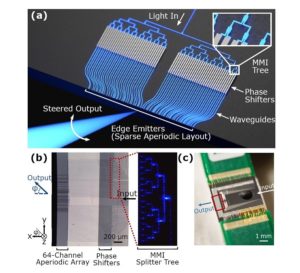WASHINGTON, March 20, 2020 — Researchers have designed a new chip-based device that can shape and steer blue light with no moving parts. The device could greatly reduce the size of light projection components used for augmented reality and a variety of other applications.
“Our blue phased array platform can rapidly and precisely reconfigure visible light for many emerging applications, spanning holographic displays, quantum information processing and biological sensing and stimulation,” said research team leader Michal Lipson from Columbia University. “It paves the way for chip-scale light projection across the entire visible range with a large field of view and can miniaturize the current bulky optical systems.”

Lipson and colleagues describe the new device in The Optical Society (OSA) journal Optics Letters. It is the first chip-scale optical phased array (OPA) operating at blue wavelengths using a silicon nitride platform. OPAs function like reconfigurable lenses by enabling arbitrary reconfigurations of 3D light patterns.
The new OPA was developed as part of a DARPA-funded project that aims to create a lightweight, low power head-mounted display that projects visible information onto the retina with extremely high resolution and a large field of view. This type of augmented display isn’t possible today because the light projection components used to shape and steer light are bulky and have a limited field of view.
Operating in the visible
OPAs offer an alternative to bulky light projection devices but are typically made using silicon, which can only be used with near-infrared wavelengths. Blue wavelengths require OPAs made from a semiconductor material such as silicon nitride that operates at visible wavelengths. However, fabrication and material challenges have made a practical blue OPA difficult to achieve.
The researchers recently optimized silicon nitride fabrication processes to overcome this challenge. In the new work, they applied this new platform to create a chip-based OPA.
“Smaller wavelengths scatter more, resulting in higher light loss if the device fabrication is not perfect,” said Min Chul Shin, co-first author of the paper. “Therefore, demonstrating an OPA that operates at blue wavelengths means we can achieve this across the entire visible range.”
Using the new blue light OPAs, the researchers demonstrated beam steering over a 50-degree field of view. They also showed the potential benefits of this type of platform for image projection by generating 2D images of letters.
“All of the chips we have tested worked well,” said Aseema Mohanty, co-first author of the paper. “Large-scale integration of this system can be accomplished using today’s lithography techniques. Thus, this new platform introduces a platform for fully reconfigurable chip-scale 3D volumetric light projection across the entire visible range.”
Applications from computing to biology
The new blue OPA could be useful for trapped ion quantum computers, which require lasers in the visible spectral range for micron-scale optical stimulation. Trapped ion quantum computers are among the most promising practical designs for quantum computing, an emerging technology expected to be significantly faster than traditional computing.
The new chip-based devices could also be used for optogenetics, which uses visible light to control neurons and other cells in living tissue. For example, the devices could be used to make an implantable device to stimulate light-sensitive tags on neurons in animal models of disease.
The researchers plan to further optimize the OPA’s electrical power consumption because low-power operation is crucial for lightweight head-mounted augmented reality displays and optogenetic applications.
Paper: M. C. Shin, A. Monanty, K. Watson, G. R. Bhatt, C. T. Phare, S. A. Miller, M. Zadka, B. S. Lee, X. Ji, I. Datta, M. Lipson, “Chip-scale Blue Light Phased Array,” Opt. Lett., 45,7,1934-1937 (2020).
DOI: https://doi.org/10.1364/OL.385201.
About Optics Letters
Optics Letters offers rapid dissemination of new results in all areas of optics with short, original, peer-reviewed communications. Optics Letters accepts papers that are noteworthy to a substantial part of the optics community. Published by The Optical Society and led by Editor-in-Chief Miguel Alonso, Institut Fresnel, Ecole Central Marseille and Aix-Marseille Université, France, University of Rochester, USA, Optics Letters is available online at OSA Publishing.
About The Optical Society
Founded in 1916, The Optical Society (OSA) is the leading professional organization for scientists, engineers, students and business leaders who fuel discoveries, shape real-life applications and accelerate achievements in the science of light. Through world-renowned publications, meetings and membership initiatives, OSA provides quality research, inspired interactions and dedicated resources for its extensive global network of optics and photonics experts. For more information, visit osa.org.
Source: The Optical Society


























































